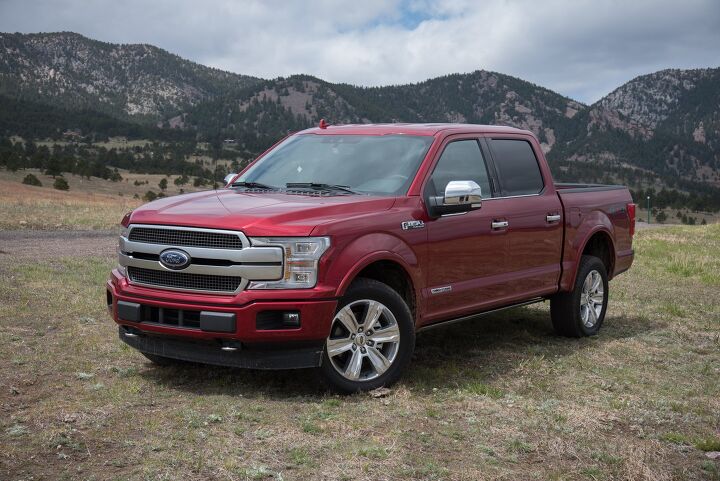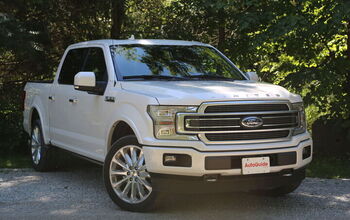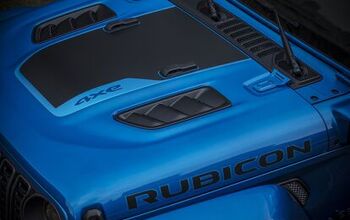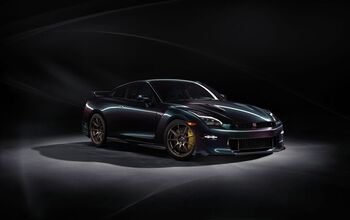2018 Ford F-150 Power Stroke Review

The Ford F-Series family has been around forever, since pretty much right after World War II. But in all the decades since its introduction, Dearborn has never offered a light-duty diesel pickup.
But that changes in 2018, because very soon you’ll be able to buy an F-150 with a Power Stroke V6, one that the folks at Ford claim delivers best-in-class towing and payload ratings, along with chart-topping fuel economy, though I suspect both Ram and GM will likely have a few things to say about these claims in the coming months.
If you’re looking for a complete review of the latest Ford F-150 you’re not going to find it here. We’ve already covered this truck extensively. In fact, it was recently named the 2018 AutoGuide.com Truck of the Year. In this review, we’re pretty much focusing on the engine and how it performs.
SEE ALSO: 2018 Ford F-150 is AutoGuide.com’s Truck of the Year
The Lion Heart
The latest offering in the F-150’s already prodigious engine lineup 3.0-liter oil-burning bent-six. With a single variable-geometry turbocharger providing the boost, it’s rated at 250 horsepower and 440 foot-pounds of torque, 10 and 20 more, respectively, than what’s offered in this truck’s main rival, the Ram 1500 EcoDiesel. A crossover pipe ensures that lone blower is fed by waste gases from both banks of cylinders.
Get the Flash Player to see this player.
FAST FACTS
| Engine: | 3.0-liter turbocharged diesel V6 |
| Output: | 250 horsepower, 440 foot-pounds of torque |
| Transmission: | 10-speed automatic |
| 2WD U.S. Fuel Economy (MPG): | 22 city, 30 highway, 25 combined |
| 4WD U.S. Fuel Economy (MPG): | 20 city, 25 highway, 22 combined |
| 2WD CAN Fuel Economy (L/100 km): | Not yet rated |
| 4WD CAN Fuel Economy (L/100 km): | Not yet rated |
| U.S. As-Tested Price: | $66,485 including $1,395 for delivery |
| CAN Estimated As-Tested Price: | $90,000 |
This is a modified version of the Lion engine family that was co-developed with Jaguar Land Rover and Groupe PSA (parent company of Peugeot and Citroen) a number of years ago, though it’s been thoroughly overhauled by the engineering team in Dearborn for truck duty. It features a forged-steel crankshaft, higher-pressure injectors that operate at 29,000 PSI as well as dual fuel filters to keep these finely calibrated instruments operating as intended. There’s also a new dual-stage oil pump for enhanced efficiency, an overhauled cooling system, and reworked crankcase-ventilation arrangement.
Just like the larger 6.7-liter Power Stroke V8 found in Ford’s Super Duty range, this engine’s block is made of compacted graphite iron, an ultra-durable material that enables thinner castings for reduced size and weight.
Capping this rugged foundation off are a pair of four-valve-per-cylinder heads. They’re actuated by roller followers and dual over-head camshafts that are driven by a Kevlar-reinforced timing belt. A chain might be better as they generally last longer, but the service interval on the belt is supposedly a hefty 150,000 miles.
Beyond all these features, this engine also boasts of a mechanically driven cooling fan, which supposedly performs far better in demanding conditions, such as towing up a mountain in the desert heat. It can move significantly more air than an electrically operated unit, better keeping under-hood temps in check.
A well-mannered 10-speed automatic transmission is a capable dance partner for this new diesel six-shooter, though it can be a bit reluctant to downshift at times. We’ll get to more of that a little further down.
Capability and Fuel Economy
But for now, let’s cover capability. When properly equipped, the 2018 F-150 Power Stroke can tow up to 11,400 pounds (5,171 kilograms). Payload tops out at 2,020 pounds (916 kilograms) in XL and XLT fleet models. Retail versions, models you’d actually want to own, top out at a little less, a mere 1,940 pounds (880 kilograms).
ALSO SEE: Top 10 Best Diesel Cars You Can Buy in the US – The Short List
As for the all-important fuel-economy figures. In its most economical form, this truck is rated at 22 miles per gallon city, 30 highway and 25 combined. Impressive EPA scores to be certain, though unfortunately, four-by-four versions are less economical. They should deliver 20 miles per gallon city, 25 highway and 22 combined, a variance that’s largely due to different axle ratios.
SEE ALSO: 2016 Ram 1500 EcoDiesel Laramie Longhorn Crew Cab 4×4 Review
For reference, this truck’s only real rival – and likely the reason it exists at all – is the abovementioned 2018 Ram 1500 EcoDiesel. According to Uncle Sam, the best it can muster with two-wheel drive is 20 MPG city, 27 highway and 23 combined.
Retail buyers can get a Power Stroke V6 in Lariat, King Ranch and Platinum models with SuperCrew bodies and either a 5.5- or 6.5-foot bed. In smaller SuperCab versions it can be had with a 6.5-foot box. If you want a regular cab or an eight-foot bed you can’t get the diesel.
Further confusing things, fleet customers are able to get this compression-ignition engine in all F-150 trim levels with SuperCab or SuperCrew bodies and the same cargo-box configurations listed in the preceding paragraph. Confused yet? Yeah, me too.
The Drive
Putting this truck through its paces in the thin air around Denver, Colorado revealed some interesting things. For starters, this baby Power Stroke is super smooth, barely whispering at idle. Run it through the rev range and it scarcely gets any louder. Vibration and harshness are also nicely attenuated, with minimal amounts of either filtering through to the F-150’s passenger cabin. For those that still remember them, the days of clattering, smoke-belching diesels are over.
The standard 10-speed automatic gearbox is similarly refined, almost imperceptibly snapping off upshifts in rapid succession while accelerating, though it’s much more reluctant to drop gears, a fuel-saving behavior that makes this truck feel a bit dull at times.
In the “Normal” driving mode you can dip deeper and deeper into the go-pedal’s travel and not much happens until you’re practically all the way down (I’m tempted to say “full bore” or “wide open” here but diesels don’t use a throttle to control airflow so this wouldn’t make any sense.). Switching the powertrain over to “Sport” noticeably wakes things up, though a four-by-four SuperCrew F-150 will never feel fast with just 250 horses in its stable and a curb weight north of 5,300 pounds (2,404 kilograms).
SEE ALSO: 2018 Chevrolet Silverado vs. 2018 Ford F-150 vs. 2018 Ram 1500
Punch it from a standstill and our test truck took a couple seconds to really move with any haste, needing at least 2,000 rpm on the clock before scooting. I evaluated another Ford F-150, one with a 6,500-pound (2,948 kilograms) boat and trailer hooked to its hitch and, not surprisingly it was in no hurry to do anything. The truck always felt stable, with the added mass hanging off its rear smoothing the ride out nicely, but acceleration was quite soft, especially while climbing hills in the thin mountain air. I’d be terrified to tow a trailer weighing anywhere near the 11,400-pound limit for fear that the truck wouldn’t go faster than 35 miles an hour (56 km/h). Hopefully, performance improves at lower elevations.
Dollars and (Common) Sense
The top-shelf Platinum four-by-four SuperCrew model I tested for this review stickered at $66,485 including $1,395 in delivery fees, but retail buyers can get a diesel Lariat model for around $46,000, which is far more reasonable.
But what’s the price premium for this engine? Well, the short answer is that it depends. Going Power Stroke in a retail Lariat model adds $4,000 to the window sticker, though that figure is only $3,000 in King Ranch and Platinum versions. As for basic XL and XLT fleet models, the upcharge is $4,995.
The Verdict: 2018 Ford F-150 Power Stroke Review
This new 3.0-liter compression-ignition V6 is a welcome addition to the F-150’s already exhaustive powertrain lineup and a strong fuel-economy play. After a day of testing, I think there’s really only one reason NOT to get one of these trucks, and it’s cost. Ultimately, you have to do the math to figure out whether the Power Stroke-tax is worth it in your specific use case.
Other than that, this is a fine pickup that will work like a farmhand day and night all while burning minimal amounts of fuel. Look for it to start arriving at dealerships in May.
Discuss this story on our Ford Forum
LOVE IT
- Impressive Refinement
- Strong Fuel Economy
- Nimble to Drive
- Stable Towing
LEAVE IT
- Confusing Diesel Availability
- Soft Acceleration
- Expensive

Born and raised in metro Detroit, Craig was steeped in mechanics from childhood. He feels as much at home with a wrench or welding gun in his hand as he does behind the wheel or in front of a camera. Putting his Bachelor's Degree in Journalism to good use, he's always pumping out videos, reviews, and features for AutoGuide.com. When the workday is over, he can be found out driving his fully restored 1936 Ford V8 sedan. Craig has covered the automotive industry full time for more than 10 years and is a member of the Automotive Press Association (APA) and Midwest Automotive Media Association (MAMA).
More by Craig Cole





























































Comments
Join the conversation